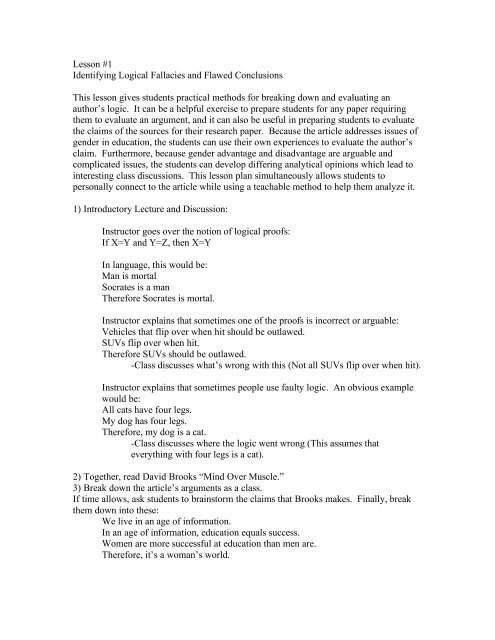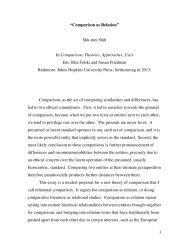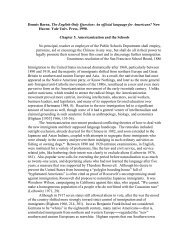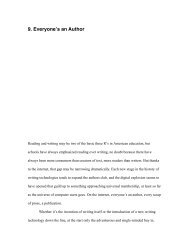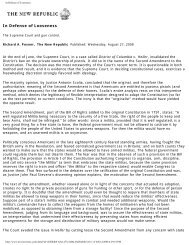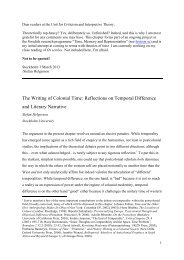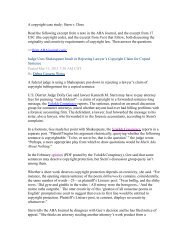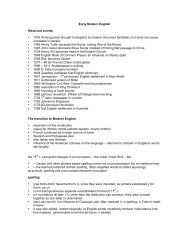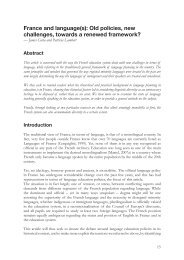Lesson #1 Identifying Logical Fallacies and Flawed ... - English
Lesson #1 Identifying Logical Fallacies and Flawed ... - English
Lesson #1 Identifying Logical Fallacies and Flawed ... - English
Create successful ePaper yourself
Turn your PDF publications into a flip-book with our unique Google optimized e-Paper software.
<strong>Lesson</strong> <strong>#1</strong><br />
<strong>Identifying</strong> <strong>Logical</strong> <strong>Fallacies</strong> <strong>and</strong> <strong>Flawed</strong> Conclusions<br />
This lesson gives students practical methods for breaking down <strong>and</strong> evaluating an<br />
author’s logic. It can be a helpful exercise to prepare students for any paper requiring<br />
them to evaluate an argument, <strong>and</strong> it can also be useful in preparing students to evaluate<br />
the claims of the sources for their research paper. Because the article addresses issues of<br />
gender in education, the students can use their own experiences to evaluate the author’s<br />
claim. Furthermore, because gender advantage <strong>and</strong> disadvantage are arguable <strong>and</strong><br />
complicated issues, the students can develop differing analytical opinions which lead to<br />
interesting class discussions. This lesson plan simultaneously allows students to<br />
personally connect to the article while using a teachable method to help them analyze it.<br />
1) Introductory Lecture <strong>and</strong> Discussion:<br />
Instructor goes over the notion of logical proofs:<br />
If X=Y <strong>and</strong> Y=Z, then X=Y<br />
In language, this would be:<br />
Man is mortal<br />
Socrates is a man<br />
Therefore Socrates is mortal.<br />
Instructor explains that sometimes one of the proofs is incorrect or arguable:<br />
Vehicles that flip over when hit should be outlawed.<br />
SUVs flip over when hit.<br />
Therefore SUVs should be outlawed.<br />
-Class discusses what’s wrong with this (Not all SUVs flip over when hit).<br />
Instructor explains that sometimes people use faulty logic. An obvious example<br />
would be:<br />
All cats have four legs.<br />
My dog has four legs.<br />
Therefore, my dog is a cat.<br />
-Class discusses where the logic went wrong (This assumes that<br />
everything with four legs is a cat).<br />
2) Together, read David Brooks “Mind Over Muscle.”<br />
3) Break down the article’s arguments as a class.<br />
If time allows, ask students to brainstorm the claims that Brooks makes. Finally, break<br />
them down into these:<br />
We live in an age of information.<br />
In an age of information, education equals success.<br />
Women are more successful at education than men are.<br />
Therefore, it’s a woman’s world.
4) Make two columns on the board for each claim <strong>and</strong> ask students to give reasons for<br />
agreeing <strong>and</strong> disagreeing with each one. (This can relate to the reading on “believing <strong>and</strong><br />
doubting” pp 44-50 of The Curious Writer, if you are using this text). Work all the way<br />
through the list. Working through the arguments, students can find interesting exceptions<br />
to most of the claims but many tend to agree with them. When they get to the conclusion,<br />
however, many tend to disagree based on women earning lower wages, having fewer<br />
positions of power, having marginal voices in the government, etc. At this point, the<br />
class can begin discussing what Brooks leaves out. Discuss how an author’s claims can<br />
all seem fairly valid <strong>and</strong> yet still come to an illogical conclusion.<br />
5) Homework Assignments:<br />
-Have students read explanations of logical fallacies. Such explanations are<br />
available in:<br />
The Curious Writer pp 321-323<br />
The Composition of Everyday Life p 290<br />
Writing Analytically pp 212-216<br />
-Have them come up with three of their own examples of logical fallacies in<br />
sentence form dealing with identification or difference with others.
The New York Times<br />
16 October 2005<br />
Mind Over Muscle<br />
By David Brooks<br />
Once upon a time, it was a man's world. Men possessed most of the tools<br />
one needed for power <strong>and</strong> success: muscles, connections, control of the<br />
crucial social institutions.<br />
But then along came the information age to change all that. In the<br />
information age, education is the gateway to success. And that means<br />
this is turning into a woman's world, because women are better students<br />
than men.<br />
From the first days of school, girls outperform boys. The gap is<br />
sometimes small, but over time slight advantages accumulate into big<br />
ones. In surveys, kindergarten teachers report that girls are more<br />
attentive than boys <strong>and</strong> more persistent at tasks. Through elementary<br />
school, girls are less likely to be asked to repeat a grade. They are<br />
much less likely to be diagnosed with a learning disability.<br />
In high school, girls get higher grades in every subject, usually by<br />
about a quarter of a point, <strong>and</strong> have a higher median class rank. They<br />
are more likely to take advanced placement courses <strong>and</strong> the hardest math<br />
courses, <strong>and</strong> are more likely to be straight-A students. They have much<br />
higher reading <strong>and</strong> writing scores on national assessment tests. Boys<br />
still enjoy an advantage on math <strong>and</strong> science tests, but that gap is<br />
smaller <strong>and</strong> closing.<br />
Girls are much more likely to be involved in the school paper or<br />
yearbook, to be elected to student government <strong>and</strong> to be members of<br />
academic clubs. They set higher goals for their post-high-school career.<br />
(This data is all from the Department of Education.)<br />
The differences become monumental in college. Women are more likely to<br />
enroll in college <strong>and</strong> they are more likely to have better applications,<br />
so now there are hundreds of schools where the female-male ratio is 60<br />
to 40. About 80 percent of the majors in public administration,<br />
psychology <strong>and</strong> education are female. And here's the most important piece<br />
of data: Until 1985 or so, male college graduates outnumbered female<br />
college graduates. But in the mid-80's, women drew even, <strong>and</strong> ever since<br />
they have been pulling away at a phenomenal rate.
This year, 133 women will graduate from college for every 100 men. By<br />
decade's end, according to Department of Education projections, there<br />
will be 142 female graduates for every 100 male graduates. Among<br />
African-Americans, there are 200 female grads for every 100 male grads.<br />
The social consequences are bound to be profound. The upside is that by<br />
sheer force of numbers, women will be holding more <strong>and</strong> more leadership<br />
jobs. On the negative side, they will have a harder <strong>and</strong> harder time<br />
finding marriageable men with comparable education levels. One thing is<br />
for sure: in 30 years the notion that we live in an oppressive<br />
patriarchy that discriminates against women will be regarded as a quaint<br />
anachronism.<br />
There are debates about why women have thrived <strong>and</strong> men have faltered.<br />
Some say men are imprisoned by their anti-intellectual machismo. Others<br />
say the educational system has been overly feminized. Boys are asked to<br />
sit quietly for hours at a stretch under conditions where they find it<br />
harder to thrive.<br />
But Thomas G. Mortensen of the Pell Institute observes that these same<br />
trends - thriving women, faltering men - are observable across the<br />
world. In most countries, <strong>and</strong> in nearly all developed countries, women<br />
are graduating from high school <strong>and</strong> college at much higher rates than<br />
men. Mortensen writes, "We conclude that the issue is far less driven by<br />
a nation's culture than it is by basic differences between males <strong>and</strong><br />
females in the modern world."<br />
In other words, if we want to help boys keep up with girls, we have to<br />
have an honest discussion about innate differences between the sexes. We<br />
have to figure out why poor girls who move to middle-class schools do<br />
better, but poor boys who make the same move often do worse. We have to<br />
absorb the obvious lesson of every airport bookstore, which is that men<br />
<strong>and</strong> women like to read totally different sorts of books, <strong>and</strong> see if we<br />
can apply this fact when designing curriculums. If boys like to read<br />
about war <strong>and</strong> combat, why can't there be books about combat on the<br />
curriculum?<br />
Would elementary school boys do better if they spent more time outside<br />
the classroom <strong>and</strong> less time chained to a desk? Or would they thrive more<br />
in a rigorous, competitive environment?<br />
For 30 years, attention has focused on feminine equality. During that<br />
time honest discussion of innate differences has been stifled (ask Larry<br />
Summers). It's time to look at the other half.


